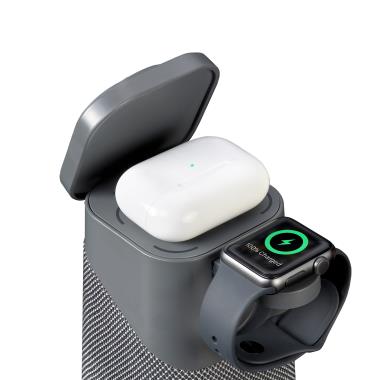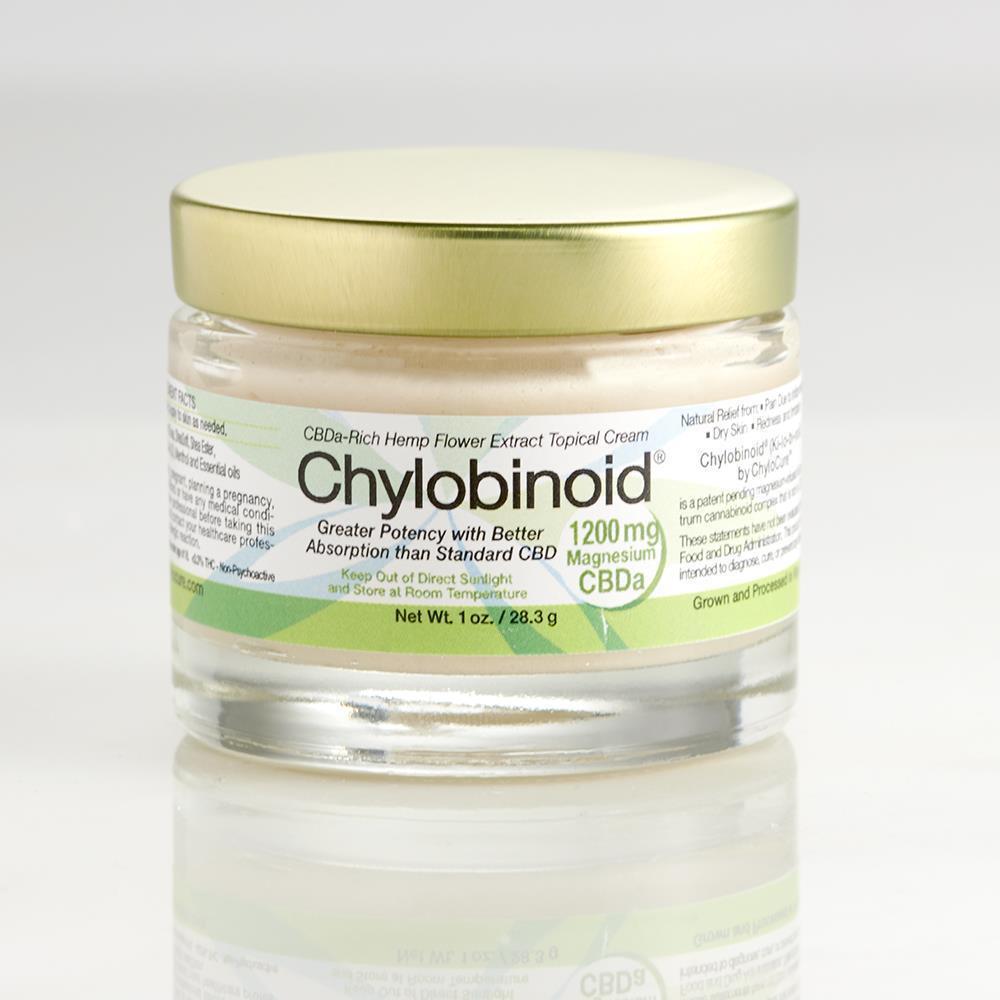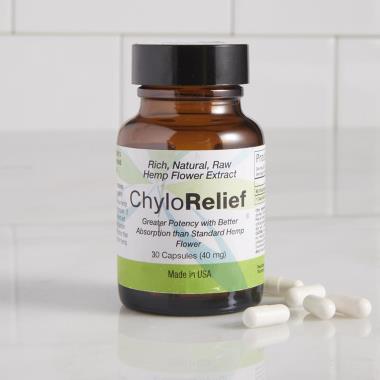The Professional's Natural Pain Relief CBDa Cream (1,200 mg)
4 (39 Reviews) ItemProduct Story
Available only from Hammacher Schlemmer, and recommended to athletes by Dr. Scott Palmer, professional sports team physician, because “it more selectively and robustly reduces pain and inflammation and penetrates deeper into the tissue”, this is the topical cream that contains 1,200 mg of the CBDa-rich compound Chylobinoid. This exclusive compound is created from 100% US produced hemp through a proprietary extraction and filtering process and is infused with Magnesium for superior absorption to deliver greater and more consistent pain relief. Scott Douglas, author of The Athletes Guide to CBD, opined that “Within two days of applying the Chylobinoid cream I began to notice significant improvement, and within a week the stiffness and tenderness was gone”. This non-prescription based CBDa cream offers the proven pain relief of 0.4% menthol and applies easily without leaving a greasy residue. Available in soothing lavender or unscented for those who prefer fragrance free products. Best when stored at room temperature of 68-72 degrees. Due to natural color differences in hemp seed harvests, the color of our CBDa cream may vary. One ounce jar.
Customer Reviews
4 (39 Reviews)The statements made regarding this product have not been evaluated by the Food and Drug Administration. The efficacy of this product has not been confirmed by FDA-approved research. This product is not intended to diagnose, treat, cure or prevent any disease. No information presented here is meant as a substitute for or alternative to information from healthcare practitioners. Please consult your healthcare professional about potential interactions or other possible complications before using any product. The Federal Food, Drug, and Cosmetic Act requires this notice.
If you are nursing, pregnant, planning a pregnancy, currently taking any medications or have any medical conditions consult your healthcare professional before using this product. Discontinue use and contact your healthcare professional if you experience an allergic reaction.
This item may not be sold in CANADA and the following U.S. states:
|
I just applied the CBDa cream. How soon will I feel relief and how long will it last?
Typically, you should begin feeling relief in 5-15 minutes and it should last for 4-8 hours. Your results may vary depending on several factors, such as the origin of the pain, its general location, and if you are engaging in any activity that aggravates the condition.
How often can CBDa cream be applied?
Although the cream can be applied as needed, most people find that 2-4 applications a day provides effective management of chronic pain.
Does CBDa cream relieve neuropathic pain?
Typically, pain caused by nerve fiber inflammation or damage (for example, from diabetes, infection, trauma, or following surgery) responds well to our cream. Pain in areas caused by nerve damage in a different part of your body (referred pain) may not be alleviated, but some customers have experienced relief of sciatica nerve pain after applying the cream to their lower back.
Does CBDa cream relieve arthritis pain?
When CBDa cream is applied consistently to the affected area, many patients experience temporary relief from pain due to osteoarthritis and inflammatory arthritis. Of course, your results may vary depending on the severity of your symptoms.
Is CBDa cream anti-inflammatory?
The cream has strong anti-inflammatory, analgesic and anti-oxidant properties that mimic the natural Endocannabinoid System (ECS). While these effects are similar to CBD, CBDa has been reported to be 100-1000x as potent at these receptor sites.
Where is the hemp used in your CBDa cream grown?
The hemp is grown and processed in Virginia. The manufacturer's proprietary extraction process is green, does not use aromatic solvents, and preserves the natural cannabinoids and terpenes from the hemp plant.
Is CBDa cream cruelty free and preservative free?
Yes, our cream is both cruelty free and preservative free.
How do you ensure the quality of the product?
The manufacturer strictly adheres to the FDA’s Current Good Manufacturing Practice Guidance in the production of Chylobinoid®.
What role does magnesium play in CBDa cream?
Magnesium, an important dietary mineral, helps our CBDa cream penetrate deeper into the skin, which allows it to reach the affected area better than conventional CBD cream
Why does my cream appear to have melted?
The cream is whipped and if over 104 degrees will start to melt. It won’t get back to the same consistency due to the air from the whipping, but it will still be as effective. Recommended storage is in room temp 68-72 degrees. Shipping carriers could exceed 100+ degrees but we do our best to minimize this.
FDA Disclosure: These statements have not been evaluated by the FDA and are not intended to diagnose, treat, or cure any disease.
For answers to many of our CBD and CBDa questions, see our Ask the Doctor Webinar recording here:
The Basics
CBD versus CBDa
CBDa is cannabidiolic acid and is what the hemp plant produces. CBD is cannabidiol and is the product of conversion, more specifically decarboxylation, of CBDa to CBD. Cannabinoids are compounds that are found in abundance in hemp and marijuana plants (see below for the difference). There are between 80 and 100 different cannabinoids isolated from the hemp and marijuana plants and virtually all of them have healthful benefits, like anti-inflammatory, sedative, and anti-biotic properties, to name a few. CBD has been the most popular cannabinoid used that does not cause the user to get “high” like THC does. However, researchers have recognized the enhanced properties that CBDa has over CBD. For example, it has been shown that CBDa is more potent than CBD in treating anxiety, depression, nausea, and inflammation.
What is Chylobinoid®?
Our products are powered by Chylobinoid®, a magnesium-infused, full-spectrum cannabinoid complex rich in cannabidioliac acid (the precursor to cannabidiol). It includes all natural ingredients that support the endocannabinoid receptor system (ECS). We believe this product has greater potency, better absorption, and enhanced bioavailability than CBD. Additionally, we find it to be more effective in treatment of pain, inflammation from microbial infections, sunburn and eczema.
Is CBD and CBDa safe?
The short answer is yes. CBD has a very long history of safe use. CBDa does too, it's just that its known history is much shorter (excluding the fact that CBDa that has been in hemp for as long as humans have been consuming hemp). There have been several studies showing the safety of CBD in animals and humans.
| HEMP vs. MARIJUANA | ||
|---|---|---|
| HEMP | MARIJUANA | |
| Cannabis Derived? | Yes | Yes |
| Plant Species | Cannabis | Cannabis |
| Plant Strain | Cannabis sativa L | Cannabis indica |
| THC Concentration by dry weight | Low THC (avg: < .3%) |
High THC (avg: 5-30%) |
| CBD Concentration | High in CBD per Mass | Low in CBD per Mass |
| Cultivation | Extremely resilient. Requires minimal care when farmed. Grows in most climates. | Temperamental. Only grown in certain climates or controlled atmosphere green houses. |
| Applications | Hemp-derived CBD, clothing, food, plastic, building material, ect. | Medical and recreational use only |
| Apperance | Skinny leaves and top heavy. Grows up to 20 feet tall. | Grows like a short, rounded bush |
The Science behind CBDa
The following scientific information is provided by the manufacturer of The Professional’s High Potency CBDa Cream.
Cannabis Value
The Cannabis plant’s use as a medicine dates back nearly 9,000 years. The active ingredients in the cannabis plant are known collectively as cannabinoids.
The most prominent cannabinoid is tetrahydrocannabinol or THC, which is found in the marijuana variety of cannabis and is the cannabinoid that is responsible for the “high” one gets when one smokes cannabis flower. The other prominent cannabinoid is cannabidiol, which is found in the hemp variety of cannabis and is the cannabinoid that has been discovered to have many healthful benefits. The cannabinoid complex is a prolific profile that also contains cannabidiolic acid (CBDa), tetrahydrocannabinolic acid (THCa), cannabigerol (CBG), cannabigerolic acid (CBGa) and cannabinol (CBN).
The cannabinoids’ importance in maintaining human health is related to the cannabinoid system in our bodies, which includes the body’s own naturally produced endocannabinoids and their receptors upon which endocannabinoids bind. Endocannabinoids, and, for that matter, all naturally produced molecules, were designed by nature over millions of years (i.e. evolution) to benefit the organism’s ability to survive. These naturally evolved molecules express their healthful benefits inside the organism’s body through a myriad of biochemical processes, such as binding and interacting with their corresponding naturally designed receptors. This evolutionary process starts from the simplest organism and continues to the most complex.3 Indeed, receptors of vertebrates (e.g. humans) and their receptor binders (also known as ligands) likely evolved from the corresponding receptors and ligands in microbes (e.g. antibiotics) and plants (e.g. cannabinoids). The evolutionary pressure placed on plants to produce natural products, such as cannabinoids, could very well have come from the vertebrates and the plants interacting with each other and sharing the benefits of co-evolution over millions of years.
Cannabinoids participate in keeping all the functions in the body in a normal operating mode even though the body is exposed to all kinds of attacks from the environment such as from the toxins we breathe and the toxins we eat. This maintenance of normal body function is known as homeostasis. Homeostasis also comes from endocannabinoids and cannabinoids acting at the intersection of the body’s various systems, allowing communication and coordination between the different parts of the body from the organs all the way down to the cells. The endocannabinoid system, with its complex actions in our immune system, nervous system, and all the body’s organs, is literally a bridge between body and mind.
It is intriguing to think that the intersection of plant and animal during the evolutionary process of both plant and animal manifest this beautifully designed symbiosis. ChyloCure is participating in the further enhancement of cannabis’ revolutionary benefits by applying science to this evolutionary remedy.
Cannabidiolic Acid Value
The health benefits of cannabinoids have been known and practiced for centuries. More than 26,000 studies and reviews referencing cannabis plants and cannabinoid molecules have been published in the recent past.
This renewed interest in cannabinoid benefits can be principally attributed to the recent discovery of the endocannabinoid receptors throughout the central nervous system.4 More specifically, many of the benefits attributed to cannabinoids stem from the effects of cannabidiol, the decarboxylated congener of cannabidiolic acid on other key receptors. While its mechanisms of action remain under study, it is proposed that the decarboxylated form interacts with multiple central nervous system receptors, ion channels and neurotransmitters. Additionally, its effects on adenosine reuptake, and the GPR-55 and TRPV1 receptors are thought to contribute to its antiepileptic properties in mice. When tested at the National Institute of Neurological Disorders and Stroke (NINDS) drug testing laboratory, Cannabidiol showed an ED50 for the MBS model of epilepsy of 85 mg/kg in mice and 89 mg/kg in rats. Cannabidiol was also active in the Metrazol model, the cardiogenic model, and other chemo-convulsant models at doses between 80 and 200 mg/kg.
As touched upon, recent identification of an integrated endocannabinoid regulatory system has helped us recognize and understand many of the health benefits of cannabinoids. This is explained, in part, by the cannabinoid molecules’ variable affinity for cannabinoid receptors expressed throughout the human body (although recently discovered, cannabinoid receptors are even expressed in very rudimentary species of animals). More recently, it has been discovered that other receptors and enzymes, such as PPAR, 5HT1A, GPCR, and COX-2, are likewise fundamental to cannabinoids’ diverse effects and mechanisms of action. Moreover, all cannabinoid acids, namely cannabidiolic acid, THCa and CBGa, outperform their corresponding neutral cannabinoids in terms of PPAR binding. This is particularly true for THCa, which has shown potent neuroprotective activity, possibly through down regulation of expression of inflammatory genes. Thus, THCa has been proposed to treat progressive neurodegenerative disorders such as Huntington’s disease and other neuroinflammatory conditions.5 Additionally, THCa has been shown in animal studies to limit the spread of prostate cancer cells.
Cannabidiolic acid, the predominant cannabinoid in many cannabis strains, demonstrates the importance of the interplay between cannabinoids and cannabinoid receptors. Much of the work demonstrating Cannabidiolic acid’s analgesic effect was conducted by Linda Parker and her associates who noted that THC’s anti-hyperalgesia was blocked by CB1 receptor antagonists, whereas cannabidiolic acid’s analogous effects were blocked by TRPV1 antagonists.6 This apparent selectivity of raw hemp extract at these transfer receptor sites is supported by Izzo7 wherein it was shown that cannabidiolic acid was an agonist for TRPA1 (nociception attenuation), TRPV1’ (cancer cell apoptosis inducer) and TRPM8.
Bolognini8 reported that cannabidiolic acid suppressed experimentally induced nausea in rats in a 5HT1A receptor-mediated manner. It was further reported that “compared with cannabidiol, cannabidiolic acid may display greater potency, efficacy and selectivity at ameliorating signs of cerebral infarction, anxiety and depression via 5HT1A receptor-dependent mechanisms in animal models.”
Considerable research on cannabidiolic acid’s interaction with COX-2 receptors has been conducted by Kazuhito Watanabe and associates at Hokuriku University. Specifically, in 2008 these researchers reported that cannabidiolic acid (~2 micromolar concentration) inhibited COX-2. It was further noted that full inhibition of the COX-2 receptor required the carboxylic acid moiety, thus cannabidiol is not nearly as active.9 Moreover, cannabidiolic acid is selective for COX-2 and does not inhibit COX-1, which is beneficial since inhibition of COX-1 may lead to unwanted side effects such as GI ulceration/bleeding and platelet dysfunction. Thus, the advantages of cannabidiolic acid’s selective inhibition of COX-2 may be quite substantial. Cannabidiolic acid’s dual inhibitory effects of COX-2 may also suppress genes associated with cancer metastasis.10 It was further determined that this COX-2 inhibition involves the down regulation of specific proto-oncogenes that promote the progression of some cancers.11 Recently it has also been shown that cannabidiolic acid has the unique ability to inhibit migration of highly invasive MDA-MB-231 human breast cancer cells.12
References Link - https://chylocure.com/science/references/








































